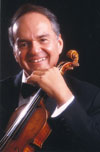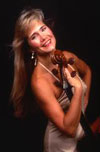
Linton Closes with Danielpour Commission

A chamber music ensemble has been compared to a marriage. Both require close cooperation, mutual
understanding and commitment to a common goal.

Violinist Jaime Laredo and cellist Sharon Robinson perform
as the Laredo-Robinson Duo (and as the Kalichstein-Laredo-Robinson Trio with
pianist Joseph Kalichstein). They are
also husband and wife and share more than a musical collaboration.
How fitting then that composer Richard Danielpour wrote and dedicated to them his “Inventions on a Marriage” for Violin and Cello. Commissioned by Linton Music and Steven Monder as part of an eight-member consortium, the work received its Cincinnati premiere on the final concert of Linton’s 2011-2012 season May 13 and 14 at First Unitarian Church and Congregation Beth Adam, respectively (this writer attended the May 14 performance.)
Also on the program were Mendelssohn’s Quintet for Strings in B-flat Major, Op.87, and Tchaikovsky’s Sextet for Strings, Op.70, “Souvenir de Florence.” Joining Laredo and Robinson in the Mendelssohn Quintet were violinist Benny Kim and violists Ida Kavafian and Steven Tenenbom. Cellist Eric Kim completed the sextet in “Souvenir de Florence.”
Danielpour did not intend to portray an actual marriage in “Inventions on a Marriage,” or Laredo and Robinson’s marriage, he said. Instead, he created a set of “snapshots,” or “invented scenarios,” that occur in most marriages and combined them into a seven-movement suite: “Mirror Image,” “Heroics,” “As You Were Sleeping,” “Argument,” “Reconciliation,” “Celebration” and “Good Night.” Laredo expanded on the movement titles and what they mean in pre-concert remarks, and you could see smiles of recognition on listeners’ faces as they “got it” during the performance.
The opening “Mirror Image” was soft and sweet, with the instruments in contrary motion throughout (reflecting the way couples mirror their thoughts and words over the years, said Laredo). “Heroics” signifies the pace of life in the contemporary world, with lots of rushing, leaping passages and a final (exhausted?) major chord. “As You Were Sleeping,” Laredo explained, pictures the couple in bed. The violin, which begins with rapid tremolo at the tip of the bow and left hand pizzicato, is snoring, while the cello lies awake, playing a languid melody. Mid-way, they trade music as the sleepers change positions in bed.
“Argument” was not rough and mean-spirited, but “elegant” (Laredo), with the instruments exchanging strong, affirmative statements and mildly dissonant harmonies. “Reconciliation,” by contrast, was tender and reflective, fading away with a soft dissonance at the end. Reflecting Danielpour’s Persian roots, “Celebration” was zesty and colorful, with a tiny upward flip by Laredo at the end. The finale, “Good Night,” was a lullaby, ending with a soft violin harmonic over a plucked cello note.
Mendelssohn’s B-flat Major Quintet is a late work, completed just two years before his tragically early death at 38. He was apparently not pleased with it (the last movement in particular), so he withheld it from publication, and it was not published until four years after his death. It is hard to understand why (and sad to contemplate what he might have composed had he lived longer), since it is so masterfully written and so rewarding to listen to.
The first movement brimmed with exuberance, Laredo taking off like a rocket over tremolo accompaniment by the other instruments. Kavafian announced the gentle second theme with warmth and beauty. The second movement, marked Andante scherzando, is not the typical quicksilver Mendelssohn scherzo, but fun-loving and laid back. The quintet gave it a performance to match, full of charm and spirit. The emotional center of the work is the Adagio lento, which grew quite impassioned, with a heartfelt restatement of the main theme by Robinson. The energetic, molto vivace finale built to a propulsive finish, with the quintet on its toes throughout.
Tchaikovsky’s “Souvenir de Florence” was the highpoint of the concert. Russian in all but name (Tchaikovsky sketched the principal theme of the second movement while on vacation in Florence, Italy), it benefited from the current of energy flowing between the Linton players. The slow second movement was a virtual love duet by Laredo and Robinson, who exchanged roles after a brief interlude where the musicians played over their fingerboards for a mysterious, flautando (flute-like) effect.
Violist Kavafian opened the third movement with the gutsy, folk-like theme, which received full bore treatment later by Robinson and Eric Kim. It grew even more intense combined with an exhilarating rhythmic accompaniment, before ending on a resounding pizzicato chord. The gypsy-flavored finale included fugato treatment of its thematic elements – a rarity for Tchaikovsky in which he took considerable pride – and a breathtaking bravura ending, which brought the crowd to its feet.
Linton Music announced its 2012-2013 season at the concert. There will be six concerts at First Unitarian Church, five of them repeating at Congregation Beth Adam. Highlights include pianist Leon Fleischer, the Kalichstein-Laredo-Robinson Trio joined by violist Nokuthula Ngwenyama, and former members of the Guarneri String Quartet in a special reunion concert with violinist Pamela Frank. For information, visit www.lintonmusic.org